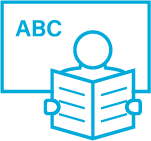Familiar Language Based Instruction versus Unfamiliar Language for the Teaching of Reading and Writing Literacy Skills: A Focus on Zambian Languages and English at Two Primary Schools in Lusaka
Author: Sitwe B. Mkandawire
Source: Mkandawire, S. B. (2017). “Familiar Language Based Instruction versus Unfamiliar Language for the Teaching of Reading and Writing Literacy Skills: A Focus on Zambian Languages and English at Two Primary Schools in Lusaka.” Zambian Journal of Language Studies, 1(1), 53–82.
This study aimed to find out if pupils in Grade 1 who were learning literacy skills in a local language in government schools were participating more actively than those learning in English in private schools, and vice versa. Despite the pace of pupil participation level in early grade classes, the major problem in the Zambian education system has been low literacy levels and high dropouts. One factor for this might be the language of instruction that some pupils did not know so well. However, since 2013, pupils from Grades 1 to 4 started learning in one of the seven regional official Zambian languages in government public schools, while most private schools still use English from early grade classes.
The study
- This study aimed to find out if pupils in Grade 1 learning literacy skills in a local language would manage to learn better than those whose language of instruction was English at one government school and one private school.
- The research questions were the following:
- What was the nature of the classes in the two schools?
- To what extent did the medium of instruction at the two schools facilitate learning?
- What was the level of class participation on the part of the pupils in class in the two schools?
- What was the attitude of the pupils, parents, and teachers towards the use of the chosen medium of instruction in schools?
- Data was collected from sixty-seven participants from two primary schools. Forty-two participants were pupils, ten were parents, and fifteen were teachers (three of whom were in the position of head teacher).
- In another school, the language of instruction was mainly a local language, Cinyanja, while in another school, which was private, pupils were learning in English.
- Three methods were used to collect data: face-to-face interviews, focus group discussions, and lesson observation. The data collected was analysed using thematic analysis.
Findings
- In the private school, the teacher systemically used English as the medium of instruction.
- In the government school, the teachers used many languages in teaching, even if the official language of teaching was Cinyanja. For example, one teacher occasionally switched to Bemba or English to facilitate the pupils’ understanding.
- In both schools, the environment was multilingual, and many languages were used during the day, for example during the breaks.
- Both languages (English and Cinyanja) used for instruction had an important role in literacy education, but depending on the pupils’ background, the language used in literacy education either facilitated or hindered learning since both languages were unfamiliar for some pupils, though most pupils used Nyanja.
- Pupils were more active during lessons taught in Cinyanja as they were able to better answer teachers’ questions than those learning in English, among whom two to three pupils were seen providing correct responses to the teacher’s questions. During the class taught in English, some pupils used other languages to talk to their peers.
- Some parents preferred that their children learn in English so that they would have some advantages in the future, e.g. greater ease in finding a job and communicating with international people. They were critical towards the policy that favours the use of local languages in education from Grades 1 to 4. Respondents argued that Grade 7 examinations were held in English and urged the government to rethink the policy, citing that it may not be enough for pupils to learn in English for two years before their examinations.
Implications
- Primary school teachers should be allowed to use multiple languages in classrooms to facilitate learning so that pupils can learn literacy skills faster.
- The limited capacity to participate in discussions in English can be seen also at the national level, where very few Zambians take part in discussions concerning social and political issues.
- Using an unfamiliar language such as English might be harmful to a child’s productive and mental processes as they do not participate actively in classes. By contrast, using a familiar language empowers the child to think, act, and process information faster.
- Children learn to value their cultural heritage when local languages can be used in education. The use of local languages also helps a sense of belonging and identity develop.



